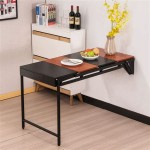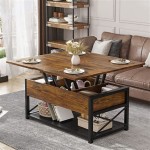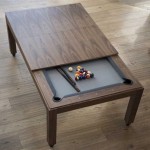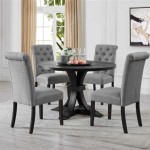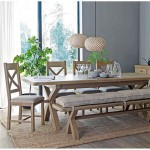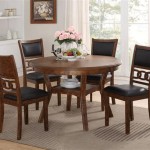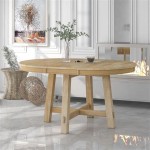The Enduring Appeal of Faux Stone Outdoor Dining Tables
Outdoor dining spaces have become increasingly popular, extending living areas beyond the confines of interior walls. As homeowners seek durable, aesthetically pleasing, and low-maintenance options for their outdoor furnishings, faux stone outdoor dining tables have emerged as a compelling choice. These tables offer the visual richness and tactile appeal of natural stone without the associated weight, cost, and upkeep demands.
This article will explore the characteristics, advantages, and considerations involved in selecting a faux stone outdoor dining table. It will examine the materials used in construction, the various styles available, and the factors to consider when making a purchasing decision. The goal is to provide a comprehensive overview of this popular outdoor furniture option, empowering readers to make informed choices that align with their individual needs and aesthetic preferences.
What is Faux Stone? Understanding the Materials and Manufacturing
The term "faux stone" encompasses a range of materials designed to mimic the look and feel of natural stone. Unlike solid stone, which is quarried and cut, faux stone is typically manufactured using composite materials. These composites may include fiberglass, resin, cement, and various aggregates to achieve the desired texture, color, and pattern.
One common method involves creating a mold from a genuine stone slab. This mold is then used to cast the faux stone material. The resulting product accurately replicates the original stone's surface details, including variations in color, veining, and texture. Pigments are often added to the mix to further enhance the resemblance to specific types of natural stone, such as granite, limestone, or travertine.
Fiberglass-reinforced polymers (FRP) are frequently utilized in the construction of faux stone table tops and bases. FRP offers exceptional strength and durability while remaining relatively lightweight. This characteristic is especially important for outdoor furniture, as it allows for easier movement and storage. The use of resin in the composite provides resistance to moisture, UV radiation, and temperature fluctuations, all of which are crucial for withstanding the harsh elements of outdoor environments.
Another approach involves using a concrete-based mixture with added polymers. This results in a heavier, more substantial product that closely resembles the weight and feel of natural stone. However, the addition of polymers helps to mitigate some of the inherent issues associated with concrete, such as cracking and staining. This type of faux stone is often used for larger table bases or for creating a more rustic or weathered appearance.
The manufacturing process often includes a protective coating or sealant to further enhance the durability and weather resistance of the faux stone. This coating helps to prevent staining, fading, and damage from moisture and UV exposure. The specific type of sealant used will vary depending on the material composition and intended use of the table.
Advantages of Choosing Faux Stone Over Natural Stone
Faux stone offers several distinct advantages over its natural counterpart, particularly in the context of outdoor furniture. These advantages encompass cost, weight, durability, and maintenance requirements.
Cost-Effectiveness: Natural stone can be a significantly more expensive option, especially for large table tops or intricate designs. The cost of quarrying, cutting, and transporting natural stone can quickly escalate, making it a less accessible choice for many homeowners. Faux stone, on the other hand, is typically manufactured using more readily available and less expensive materials, resulting in a lower overall cost.
Reduced Weight: The weight of natural stone can pose a significant challenge when it comes to outdoor furniture. A solid stone table top can be extremely heavy, making it difficult to move or reposition. This can be problematic for homeowners who frequently rearrange their outdoor spaces or need to store their furniture during the off-season. Faux stone, particularly when constructed with FRP, is significantly lighter, making it easier to handle and transport.
Enhanced Durability: While natural stone is generally durable, it can be susceptible to certain types of damage, such as chipping, cracking, and staining. Porous stones like limestone and travertine are particularly vulnerable to staining from spills and moisture. Faux stone, with its engineered composite materials and protective coatings, is often more resistant to these types of damage. It is less likely to stain, fade, or crack under normal outdoor conditions.
Lower Maintenance: Natural stone requires regular sealing and cleaning to maintain its appearance and prevent damage. This can be a time-consuming and labor-intensive process. Faux stone, with its protective coatings and non-porous surfaces, typically requires minimal maintenance. Regular cleaning with soap and water is usually sufficient to keep it looking its best.
Design Versatility: Faux stone can be molded into a wide variety of shapes, sizes, and styles, offering greater design flexibility than natural stone. Manufacturers can create faux stone tables that mimic the look of virtually any type of natural stone, allowing homeowners to achieve their desired aesthetic without the limitations of natural materials.
Key Considerations When Selecting a Faux Stone Outdoor Dining Table
Choosing the right faux stone outdoor dining table requires careful consideration of several factors, including size, style, material composition, and environmental conditions.
Size and Shape: The size and shape of the table should be appropriate for the intended use and the size of the outdoor space. Consider the number of people who will typically be using the table and the amount of space available around it. Round tables are often a good choice for smaller spaces, while rectangular tables are better suited for larger gatherings. Ensure that there is adequate clearance around the table for chairs and movement.
Style and Design: Faux stone tables are available in a wide range of styles, from rustic and traditional to sleek and contemporary. Choose a style that complements the overall aesthetic of the outdoor space and the existing furniture. Consider the color, texture, and pattern of the faux stone, as well as the design of the table base. Some tables feature ornate bases made of wrought iron or aluminum, while others have simple, minimalist designs.
Material Composition: Pay close attention to the materials used in the construction of the table top and base. Look for tables that are made with high-quality composite materials and protective coatings. Consider the specific characteristics of each material, such as its resistance to moisture, UV radiation, and temperature fluctuations. Tables made with FRP are generally lightweight and durable, while those made with concrete-based mixtures are heavier and more substantial.
Environmental Conditions: Consider the specific environmental conditions in the area where the table will be located. If the table will be exposed to harsh sunlight, choose a material that is resistant to fading and UV damage. If the table will be exposed to frequent rain or snow, choose a material that is waterproof and resistant to corrosion. If the table will be located in a windy area, consider choosing a heavier table or one with a sturdy base to prevent it from being blown over.
Maintenance Requirements: While faux stone generally requires minimal maintenance, it is still important to understand the specific cleaning and care requirements of the material. Follow the manufacturer's instructions for cleaning and sealing the table. Avoid using harsh chemicals or abrasive cleaners that could damage the surface. Regularly inspect the table for any signs of damage, such as cracks or chips, and repair them promptly to prevent further deterioration.
Budget: Faux stone outdoor dining tables vary in price depending on their size, style, and material composition. Set a budget before you begin shopping and stick to it. Compare prices from different retailers and look for sales or discounts. Consider the long-term cost of ownership, including maintenance and repair costs, when making your decision.
By carefully considering these factors, homeowners can select a faux stone outdoor dining table that meets their needs, complements their outdoor space, and provides years of enjoyment.
The versatility and benefits offered by faux stone have cemented its position as a worthwhile consideration in the domain of outdoor decor. From its lightweight nature to its ability to withstand harsh environmental elements, it continues its reign as a popular choice for outdoor dining.

New Faux Stone Concept A High End Look Without The Hefty Tag Teemo

Faux Stone Pineapple Bistro Table Frontgate Outdoor Patio Decor Set

Concrete Outdoor Furniture Kathy Kuo Home

Tommy Bahama Pavlova 60 Round Dining Table 3910 870

Summer Classics Fisher French Country White Stone Outdoor Dining Table 36 W 31 40 Kathy Kuo Home

Faux Stone Pineapple Bistro Table Frontgate Outdoor Patio Decor Furniture Sets

Details Custom Faux Stone Table Top

Modern Dining Table

7 Pieces Outdoor Dining Set With Oval Faux Marble Top Table And Rope Woven Armchair Stone

Stone Outdoor Settings Tables Chairs Elegance

